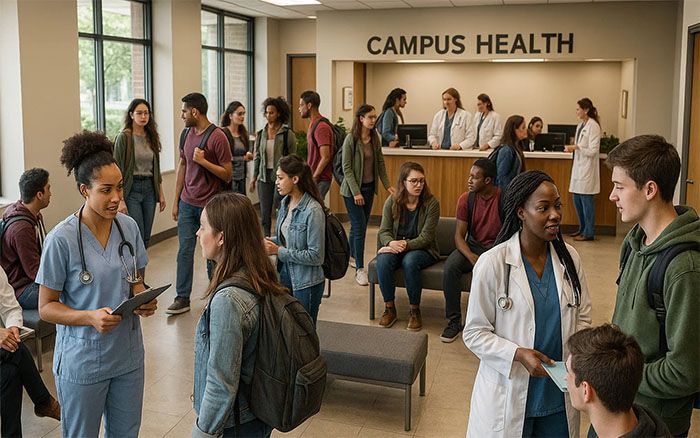How to Bring Peer Support to Your Campus
A Guide to Building and Sustaining Successful Programs
Peer support programs have become a vital part of supporting student mental health, empowering students to connect and support one another. These initiatives help reduce the stigma surrounding mental health, creating supportive networks where students can openly share their experiences and challenges.
The structuring of these programs can vary, but at their core, they are student-led initiatives that create a safe space for mental health conversations.
In this blog, we’ll discuss the benefits of peer support programs and how to incorporate a peer support program on your campus. We’ll also share insights from Clare Kehoe and Lindsey Kilpatrick from Morgan’s Message, an organization shedding light on student-athlete mental health and peer support programs.
But First – Why Are Peer Support Programs So Important, Anyway?
Peer support programs are designed to foster connections among students, allowing them to share experiences and provide mutual support. The structure of these programs can vary, but at their core, they are student-led initiatives that create a safe space for mental health conversations.
Studies show that 20% of college students engage in formal peer counseling, and another 62% of those who haven’t yet used it express interest in doing so. The most common reasons students seek peer support include:
- Stress
- Anxiety
- Depression
- Social Life Challenges
- Loneliness
Moreover, culturally competent peer counseling is especially important, as usage is higher among Black students (39%), Transgender students (39%), and first-generation students (29%). These students often prioritize finding peer counselors with shared identities and experiences.
Not only do students want support, but they also find meaning in giving it. Around 45% of students who provide peer counseling cite “helping others” as their primary motivation. Also, those involved in peer counseling report higher well-being scores than those who do not participate.
A significant portion of students—36%—say that, when facing a serious mental health issue, they would first turn to a friend or romantic partner for support. The desire for peer support has been amplified by the COVID-19 pandemic, with 48% of students reporting they are now more likely to seek peer counseling. This is especially true for Black students (58%), Latinx students (54%), Transgender students (61%), and first-generation students (54%).
The Advisor’s Role in Peer Support Programs: Dos and Don’ts
Having a staff or faculty advisor is crucial for the success of peer support programs. Advisors provide essential support, strengthen the initiative, and help drive meaningful change on campus. They bridge student-led efforts with the broader campus community, ensuring alignment with institutional goals and securing necessary resources.
Here’s a quick guide to maximize their impact:
Dos for Advisors:
- Facilitate logistics: Help students reserve rooms, coordinate schedules, and manage event setups.
- Provide administrative support: Ensure compliance with campus policies and assist with communication across departments.
- Empower student leaders: Offer guidance without overshadowing or micromanaging their initiatives.
- Foster collaboration: Serve as a bridge between student groups and campus administration to align efforts with institutional goals.
- Encourage skill development: Help students build skills in organization, communication, and leadership through their roles in the program.
Don’ts for Advisors:
- Take over decision-making: Allow students to lead and own their programs to maintain the authenticity of peer support.
- Limit creativity: Avoid imposing rigid structures that could stifle innovation, collaboration, or enthusiasm.
- Undermine student voices: Always prioritize and respect student input and lived experiences in shaping program initiatives.
- Neglect program alignment: Ensure that the program consistently reflects the mission and needs of the campus community.
Focusing on these dos and don’ts creates an environment where students thrive, fostering collaboration and lasting impact through peer support programs.
Maximizing the Impact of Peer-Led Programs
According to the College Peer Support Report 2023, peer-led initiatives are uniquely positioned to address a wide range of student needs, from fostering inclusion to supporting academic and emotional well-being. To ensure these programs reach their full potential, campuses should focus on four key strategies:
- Empower Students and Those with Lived Experiences to Lead: Student-led programs are uniquely positioned to address broader issues that impact student engagement and inclusion. Unlike staff-led initiatives, these programs often offer group activities, academic support, and opportunities to foster community connections, making them a cornerstone of holistic well-being on campus.
- Provide Comprehensive Peer Support Training: While all students involved in peer support programs should feel adequately trained, there is a demand for additional resources. Training that focuses on systems navigation, cultural humility, and addressing specific mental health experiences—such as psychosis or self-harm—can empower student leaders to point fellow students towards critical support.
- Adopt a Trauma-Informed Approach: Ensuring that programs are trauma-informed is critical for supporting student mental health effectively. Peer leaders often express the need for tools to redirect students in crisis towards accessible and thoughtful support options that will help, not further harm, their peers.
- Invest in Peer Support Programs: Sustainable funding is essential for growing and maintaining impactful peer support initiatives. These programs not only enhance campus well-being but also expose students to potential careers in mental health, creating a ripple effect of positive change. Investments in educational resources and inter-campus collaboration efforts can further expand the reach and effectiveness of peer support programs.
Strategies for Success
Peer support programs thrive when they engage students in meaningful activities, such as mental health education games or mindfulness workshops. These events help students build skills to manage stress while fostering openness and reducing stigma.
Collaboration across campus is another critical factor in amplifying these programs’ impact. Partnering with other groups allows peer-led initiatives to influence broader policies and create a unified approach to student well-being.
For example, at UMass Lowell, Morgan’s Message inspired the Athletic Director to hire the university’s first-ever athletics-specific mental health counselor. This success story illustrates how peer programs can spark transformative change:
To ensure effectiveness, campuses should prioritize:
- Elevating student leadership and lived experience
- Offering ongoing training for peer leaders
- Using a trauma-informed approach
- Investing in long-term program sustainability
When combined with collaboration and campus-wide engagement, these strategies can create lasting change in supporting student mental health.
The Power of Peer-Led Support
Peer support programs not only reduce the stigma surrounding mental health but also build lasting support systems for students. Empowering students to lead these initiatives fosters a sense of belonging and strengthens campus communities.
Research highlights the unique value of peer-led programs, which often complement staff-led initiatives. While clinical counseling programs address more advanced and specific mental health needs, peer-led programs offer holistic opportunities for students to connect vulnerably with one another. Together, these approaches ensure students have access to a diverse menu of mental health resources to meet their needs.
Creating mentorship opportunities and safe spaces for connection, peer-led initiatives play a crucial role in ensuring no student feels isolated. These programs help students thrive—academically, socially, and emotionally—while reinforcing the importance of shared experiences and mutual support.
Key Takeaways
Peer support programs are essential for fostering a healthy, supportive environment on college campuses. Creating spaces where students can turn to their peers for help improves mental health outcomes and strengthens the sense of connection within the campus community.























